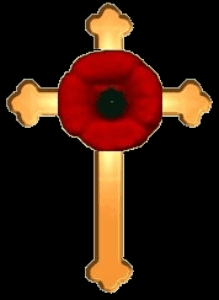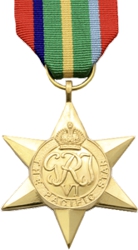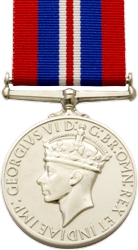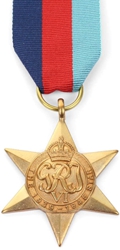|

871199
Gunner
Alfred Edward Perry

1911/09/20 - Born Birmingham
1939/09/01 - Enlisted
Royal Artillery
3 Heavy Anti-Aitcraft
30th Battery
1941/11/01 - Arrived Singapore
Information supplied by Captain A.A Apthorpe, Royal Norfolk Regiment.
1942/02/16 - Left Singapore in Chinese Junk for Sumatra.
Party:-
CO Major Rolley Conway, 30th Battery 3 H.A.A.
(left party for India, now Col. and OBE)
Captain Morley, 30th Battery, 3 H.A.A.
(Took over command)
Captain Walker, HKS
Davies, Dicker, Pervis, McPatre
Stranded on rocks near Saint John’s Island for two days. Ship refloated with assist of Malays.
17 days on Chinese junk - lost - water and food shortage.
Tracked through jungle and swamp eventually after much hardship arrived at Padang March 11th.
Entry of Japanese troops the night of 16th March.
1942/03/17 - Taken prisoner, disarmed by Dutch troops after entry of Japanese Troops.
1942/04/09 - WO 417/41, Casualty List No. 793. Reported ‘Missing’.
1943/09/15 - WO 417/66, Casualty List No.1239. Previously shown on Casualty List No.793 as Missing, 15/02/1942. Now reported ‘A prisoner of War’.
Japanese PoW
1942/03/17 - Captured Padang, Sumatra.
PoW No. 3456
Japanese Index Card - Side One

Japanese Index Card - Side Two

1942/05/09 - The British Sumatra Battalion was formed with 20 officers and 480 other ranks. The service personnel were mostly escapees and considered to be trouble makers.
Leaving Padang, Sumatra by train they travelled to Fort de Kok. The next day a convoy of lorries took them to Uni Kampong Camp, where Dutch civilians were interned.
1942/05/15 - The British Sumatra Battalion were packed into the hell ship ‘England Maru’ bound for Mergui, Burma, to build new runways, the death rate at Mergui was twelve.
Transported to Burma in a convoy of four ships:-
Toyohoshi Maru (Australians ‘A’ Force)
Kyokusei Maru (1200 Dutch, Harry’s transport ?)
England Maru (500 from British Sumatra Battalion)
Celebes Maru (1000 Australions from Singapore)
The 10th of August saw another move on the hell ship Tatu Maru to Ann Hestletine Home at Tavoy, where the death rate fell to five.
New PoW No. VIII 3456.
The next move to Thanbyuzayat in November was the start of a hard toil on the Thailand to Burma railway.
Worked with the Dutch on the railway in Group 3
The death rate being:
|
Burma
|
|
|
|
|
Thanbyuzayat
|
14
|
|
18 Kilometer Camp
|
1
|
|
30 Kilometer Camp
|
6
|
|
55 Kilometer Camp
|
20
|
|
60 Kilometer Camp
|
16
|
|
84 Kilometer Camp
|
1
|
|
105 Kilometer Camp
|
1
|
|
114 Kilometer Camp
|
39
|
|
Thailand
|
|
|
|
Tamarkan
|
8
|
|
Kanchanburi
|
26
|
|
Nakan Paton
|
1
|
After the railway was finished, in March 1944, the British Sumatra Battalian were split up, 140 had died, 190 were at Kanchanburi Hospital and forty were still in camps along the railway line. The Japanese wanted parties for Japan and out of 2034 Dutch, Australian, American and British prisoners, seven parties (Kumis) were formed. Each kumis consisted of an officer, medical orderly and 150 other ranks. The British Sumatra Battalion formed the 51 Kumi Party bound for Saigon, French Indo China.
Alfred was in the 51 Kumis bound for Saigon, French Indo-China
New PoW No. VIII 12776 - Work Group 8
Kumis 49 (Americans), 50 (mixed nationalities) and 51 (British) arrived at the Saigon Camp situated on the Rue Catinat where one death occurred.
The 200 left behind in Burma when the 51 Kumis left, were forced from the hospital camps at Kanchanburi and Tarmakan and helped build the Tavoy Road, whilst others formed maintenance parties on the railway.
1944/03 - The 51 Kumis were transported by train to Non Pladuk where they spent a week.
1944/03/18 - then on to Bangkok. There followed a very long journey of about 400 mile by train to Phnom Penh in French Indo-China. which is on the banks of the Mekong River.
1944/04/ Barges were used to cross the Mekong and then a steamer for the final part of their transport to Saigon.
Their final destination was supposed to be Japan but the 51 Kumis but the PoWs were marched to an old French Barracks, finding the previous Australian and Dutch Kumis from Burma already there. They joined about 400 british Pows who had been at Saigon for the last two years occupying five large wooden huts.
The 51 and 49 Kumis from Burma were housed in the old disused Jail.
Lt-Col. Hugonan was the Senior officer of the camp which was situated on the Rue Catinat on the main thoroughfare between the native quarter and French quarter of Saigon. All the huts were wooden, except for the bamboo and attap roofed hospital. All huts had electric lights. The main work was loading barges with rice but also moving oil drums from fuel dumps to the airfield.
The freshly arrived Burma PoWs were told two Pows had tried to escape but were caught at the station by the Vichy French trying to board a train for Hanoi. They were handed over to the kempetai, tortured then beheaded, this was a warning.
The camp was made up from English Resident Troops, or ERTs as they became known and the Burma Kumis (Transit Troops), the two groups were kept separate with different Japanese guards so they did not mix.
The hours of work were 9am to 6.30pm with a two hour break mid day for lunch. The PoWs found the situation far from the terrible conditions on the Thailand-Burma, they even had a tap for drinking water.
In May 1944 the Kumis, or TTs, were supposed to have continued their journey to Japan but it was delayed and their temporary huts were over crowded, so in June the Australians from the Burma railway were amalgamated with the ERTs.
While loading the sacks of rice into the ships at the docks, Bill and his mates would urinate on them so the cargo swelled up in transportation, hopefully causing problems . They never found out if it worked.
In November an ERT escaped from the aerodrome and the Japanese built a bamboo fence around the camp and the Japanese security was tighter. It did not help when an American pilot also walked out of the camp and the Japanese took it out on the remaining PoWs. Hourly roll calls were put into place.
Early in 1945 more PoWs arrived and were placed in the old hospital camp, this was followed by increased bombing raids.
Then came the ditches being dug around the camps, the PoWs were in no doubt that the ditches were for them as the end was seen to be in sight. The guards were then replaced with much older men and the fighting guards were taken away. Japanese planes and shipping were bring destroyed in air raids and this added to the belief that the end of the war was near.
Security became less and then faded away completely. French families even invited the PoWs into their homes for meals but this was ended when the native population started attacking the French families, they wanted independence from French rule. The PoWs still did not realise that they were free until British and Dutch paratroopers dropped into the camp and got the PoWs organised.
1945/09/13 - Liberated Saigon
Then the airlift to Rangoon, via refuelling at Bangkok, started taking place, and after being hospitalised in Rangoon - home.
Liberation Questionnaire
1945/11/12 - WO417/99, Casualty List No. 1908. Previously shown on Casualty List No. 1239 as reported Prisoner of War now Not Prisoner of War. Previous Theatre of War, Malaya.
|

|

|

|
|
Pacific Star
|
War Medal
|
1939-1945 Star
|
|
|
|
Post War
1950 Alfred emigrated to Canada with his young family.
Information
Liberation Questionnaire - COFEPOW
‘The British Sumatra Battalion’ by A.A. Apthorpe (Book)
Thailand Burma Railway
KEW Files:- WO 361/2172, WO 392/25, WO 345/40, WO 361/1955, WO 361/2196, WO 361/2027, WO 361/1987, WO 361/2168,
|